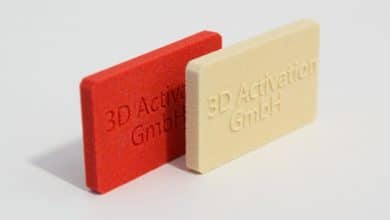
Contents
Everything you should know about 3D printing titanium
Titanium is still a newcomer to the list of 3D printable materials. Introduced at the beginning of 2011, the light metal with the chemical atomic number 22 has long since secured a permanent place among 3D printing materials, not least thanks to its suitability for medical products such as artificial hip joints.
Reason enough to show you titanium and its many uses as a 3D printing material in more detail.
Titanium: Its Discovery and Properties
Titanium, a Group 4 transition metal, is one of the 10 most common elements found in the earth’s crust, although it is mostly found as a component of minerals.
Titanium was discovered in Cornwall/England in 1791 by the clergyman and amateur chemist William Gregory (1761 – 1817), but this light metal got its name in 1795, when the German chemist Martin Heinrich Klaproth (1743 – 1817) also discovered it and referred to the Greek gods of the Titans (giants in human form) when naming it. This choice of name already shows that Klaproth gave the Titan a considerable potential.
This synthesis of titanium from metallic ore only began in 1831, when the well-known German chemist Justus von Liebig (1803 – 1873) discovered a first method for this. Titanium synthesis continued to improve over the following decades William Justin Kroll (1889 – 1973), a Luxembourgish researcher and metallurgist, who finally achieved a breakthrough in the late 1930s with the Kroll process named after him (patented in 1940). Since then, the production of technically pure titanium has no longer been a problem.
The melting point of titanium is 1668°C and its boiling point is 3260°C. Up to 882°C, the paramagnetic titanium has a hexagonal crystal structure and its density is 4.50 g/cm3 (at 25°C).
Titanium as a 3D printing metal
Like most other metals, titanium is also printed using Selective Laser Melting (SLM). In this case, around 1995 by the Aachener Fraunhofer Institute for Laser Technology (ILT) Using the developed 3D printing process, the metal, which is in powder form, is applied as a thin layer (approx. 30 – 50 μm) to a printing plate (also referred to as a substrate plate), where it is locally melted using a laser beam, according to the structure specified in the CAD files (as we already reported in our blog). To protect against undesirable chemical reactions, this process takes place in an inert gas atmosphere of argon or nitrogen.
After printing, the model is first pre-hardened and infiltrated before being placed in a blast furnace heated to over 1000°C and then polished.
The introduction of SLM Titan printing in January 2011 brought a significant step towards greater accuracy and strength in additive manufacturing.
The properties of 3D printing titanium
The one used in 3D Activation Ti64 impresses with high corrosion resistance, biocompatibility and its low weight. It can be printed with wall thicknesses from 0.3 mm, with an accuracy of up to 0.5 mm.
application areas
Medical technology is one of the most important areas of application for titanium, followed by aircraft construction. Another area of application for titanium printing that should not be underestimated is the manufacture of jewellery.
Would you like to learn more about titanium and other possibilities of metal 3D printing? Visit our website.
to materials



